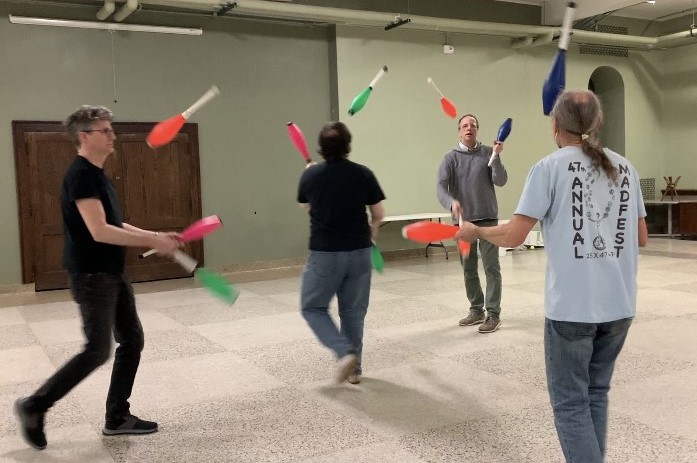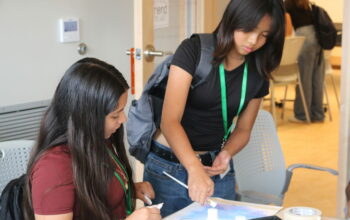Michelle Hackett, 45, started juggling six years ago to combat cognitive issues that developed from a tumor on her adrenal gland.
The tumor increased Hackett’s levels of cortisol, a stress hormone that at high levels made it difficult for her to sleep. Going without sleep damaged her cognitive functioning. But Hackett, who works installing software in restaurants and owns an entertainment company based in Milwaukee, knew from her involvement in the circus arts scene that juggling enhances cognitive ability.
Hackett joined the Madison Area Jugglers, a local juggling group, three years ago.
Since then, juggling with the group has not only sharpened her cognition — it’s also brought her social connections. Nick Aikens, 39, who joined the group in 2010, helped her progress from juggling balls to juggling clubs, the pin-shaped props jugglers often use. Now Hackett and Aikens are life partners.
“Everybody should juggle,” Hackett said. “It is so incredibly good for your mind and warding off dementia and just keeping your cognitive reality. And the connection that people experience when they're doing pass juggling is really cool.”
Members of the Madison Area Jugglers, a group known worldwide for its club passing patterns involving multiple jugglers, range from amateurs to professionals. Group members do some individual juggling, but they mostly pass clubs to each other in large passing patterns during twice-weekly practices and occasional performances.
Mark Hayward, professional juggler, yo-yo man and full-time variety arts performer, 50, said club passing requires interest, skill and patience not present at the same level in other juggling clubs.
“There's so many juggling clubs around the world, and sure, there are plenty of good passers around the world, but to have a group of this many people who are this interested and committed is just super rare,” Hayward said.
Members join the juggling club for a variety of reasons, but the social aspect keeps long-time members, like Michael Newton, 58, coming back. Newton joined the group in 1991.
“Lots of places have juggling clubs,” Newton said, “but because our juggling club is especially focused on these activities where we throw things at each other and we try and figure out ways to do that and move in complicated new ways we haven't done before – that's been, I think part of the reason it survived.”
Members of the group pass clubs to each other in the Madison Circus Space on Sunday afternoons and in the basement of the First Congressional Church on University Avenue Thursday evenings. On warm Thursday evenings in the summer, they juggle near Library Mall on the University of Wisconsin-Madison campus.
The group requires no dues, attendance records, age requirements or membership restrictions, according to its website.
“It's very informal, and yet somehow it still works,” Hayward said. “We have enough core members, so people who come all the time or most of the time, that we've been able to maintain a thriving group for so long without really any structure or hierarchy.”
Highly skilled jugglers comprise core members of the group, Hayward said. They help teach beginners but also offer feedback and assistance to each other on high-level tricks.
But jugglers are also a group of people who like to play, Hayward said.
“The main thing I love is the big passing patterns, partly because it's a fun three-dimensional puzzle and a physical challenge,” Hayward said. “But also it's social. It's a great way to spend time with fun people doing fun things.”
The Madison Area Jugglers also share their passion for club passing with jugglers from outside the Madison area. The group has hosted a juggling convention called Madfest every year since 1992; this year’s three-day festival was the 47th. It’s a running joke among the group, said Hayward, who organized the first year of the festival.
The convention includes workshops, vendors and a Juggling Extravaganza show held at the Barrymore Theatre in Madison.
On the Sunday of the festival, the group works on “the big pattern,” a pre-arranged pattern that sometimes includes more than 30 jugglers. The largest pattern at Madfest this past January included 28 jugglers, Newton said.
The sound of props hitting the floor, frequent laughter and occasional shouting during practices attracts some members to the club, Hayward said.
Hayward rides his RipStik at practice, sometimes while juggling. Some members also manipulate other juggling-related props like diablo, which spin in the air as a juggler manipulates the two discs with sticks they hold in each hand.
“The juggling club is fairly raucous,” Hayward said. “We're fairly loud, there's the crashing of the props and the hooting and hollering and there's a lot of laughter. So, I think that's appealing to people as well.”
Before the COVID-19 pandemic, the group faced stagnant membership, with a core group of members attending practices, Hayward said.
But after the pandemic, more women, college-aged people and younger children started attending juggling sessions, particularly Sundays at the Madison Circus Space, Hayward said.
When the group noticed people interested in learning how to juggle during the pandemic, they posted videos on social media encouraging them. They helped them get props or build juggling balls at home. They encouraged beginners to come to in-person practices once they would start again, Hayward said.
Hackett notices more women at practices than she did when she first joined the group. She is unsure what prompted the increase but hopes the group’s outreach efforts caused it, Hackett said.
“We've been really trying to make an effort to make women feel more comfortable as jugglers in the juggling space and everything like that,” Hackett said. “We've thrown around the idea of doing a ladies' night for juggling at the Madison Circus Space.”
Many people who started coming to juggling sessions at the Madison Circus Space also practice other circus-related arts like aerial arts and acrobatics, Hayward said.
Newton, who is chair of the biostatistics and medical informatics department at UW-Madison, started composing a handbook of the groups’ passing patterns in the early ’90s. Newton and other members writing the handbook struggled to remember how to do all the patterns and variations they worked on.
The most recent version of the Madison Area Jugglers’ Pattern Book includes more than 150 pages of descriptions of passing patterns the group does during practices, complete with tables and figures.
Some patterns the group learned from other jugglers, but most patterns and variations they created themselves, Newton said. The names of some patterns reflect this.
Juggling with the group gives Aikens, a former board member of the Madison Circus Space, a mental and physical challenge as well as an opportunity to socialize, he said.
“I'm a very collaborative person, and there aren't a lot of activities that are both physically challenging and not competitive,” Aikens said. “And it also allows me to be nerdy.”
Aikens wrote a computer program to generate passing patterns using Siteswap, a number system some jugglers across the world use to record patterns. Each number represents a certain throw and conveys information about timing, placement and height relative to other throws. Strings of these numbers make up a pattern.
Hackett and Aikens sometimes try these passing patterns together at practices. Their differences in skill level played a role in Aikens’ generation of the patterns, Hackett said.
“I inspired him because of my low ability, and he wants to include me in patterns,” Hackett said. “So he tries to create patterns that I can handle. He’s so adorable.”





